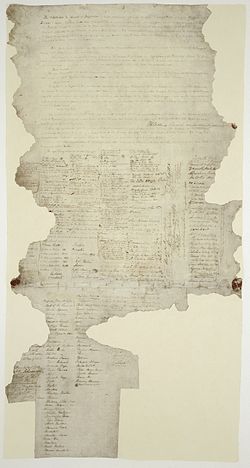Treaty of Waitangi

One of the few extant copies of the Treaty of Waitangi
|
|
| Context | Treaty to establish a British Governor of New Zealand, consider Māori ownership of their lands and other properties, and give Māori the rights of British subjects. |
|---|---|
| Drafted | 4–5 February 1840 by William Hobson with the help of his secretary, James Freeman, and British Resident James Busby |
| Signed | 6 February 1840 |
| Location | Waitangi, Bay of Islands, New Zealand, and various other locations. Currently held at Archives New Zealand, Wellington. |
| Signatories | Representatives of the British Crown, various Māori chiefs from the northern North Island, and later a further 500 signatories. |
| Languages | English, Māori |
|
|
|
The Treaty of Waitangi (Māori: Tiriti o Waitangi) is a treaty first signed on 6 February 1840 by representatives of the British Crown and various Māori chiefs from the North Island of New Zealand. It resulted in the declaration of British sovereignty over New Zealand by Lieutenant Governor William Hobson in May 1840.
The Treaty established a British Governor of New Zealand, recognised Māori ownership of their lands, forests and other properties, and gave the Māori the rights of British subjects. In return the Māori people ceded New Zealand to Queen Victoria, giving her government the sole right to purchase land. The English and Māori versions of the Treaty differed significantly, so there is no consensus as to exactly what was agreed. From the British point of view, the Treaty gave Britain sovereignty over New Zealand, and gave the Governor the right to govern the country. Māori believed they ceded to the Crown a right of governance in return for protection, without giving up their authority to manage their own affairs. After the initial signing at Waitangi, copies of the Treaty were taken around New Zealand and over the following months many other chiefs signed. In total there are nine copies of the Treaty of Waitangi including the original signed on 6 February 1840. Around 530 to 540 Māori, at least 13 of them women, signed the Treaty of Waitangi.
In the 1970s the treaty gained prominence amid greater awareness of Maori issues and grievances, particularly with regard to land claims. Māori have looked to the Treaty for rights and remedies for land loss and unequal treatment by the state, with mixed success. From the late 1960s Māori began drawing attention to breaches of the Treaty, and subsequent histories have emphasised problems with its translation. In 1975, the Waitangi Tribunal was established as a permanent commission of inquiry tasked with researching breaches of the Treaty by the British Crown or its agents, and suggesting means of redress.
...
Wikipedia
